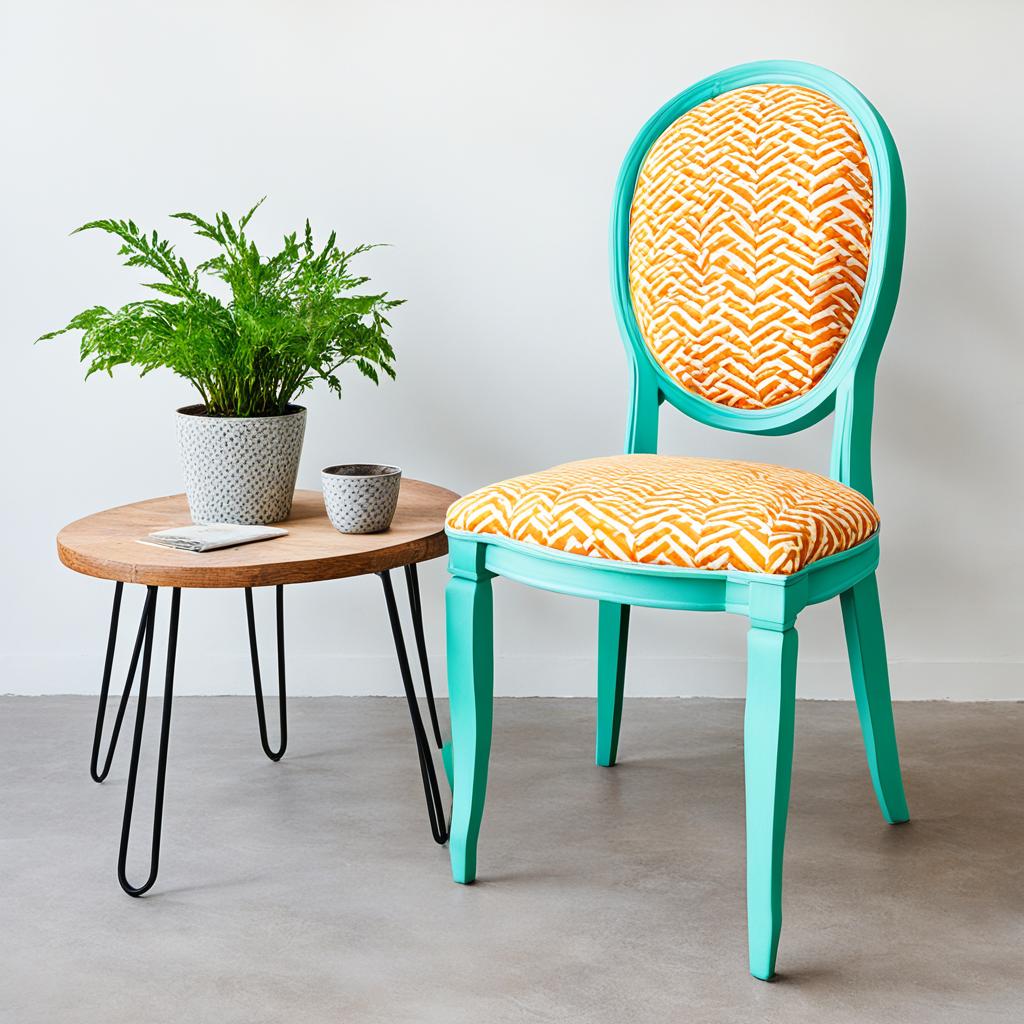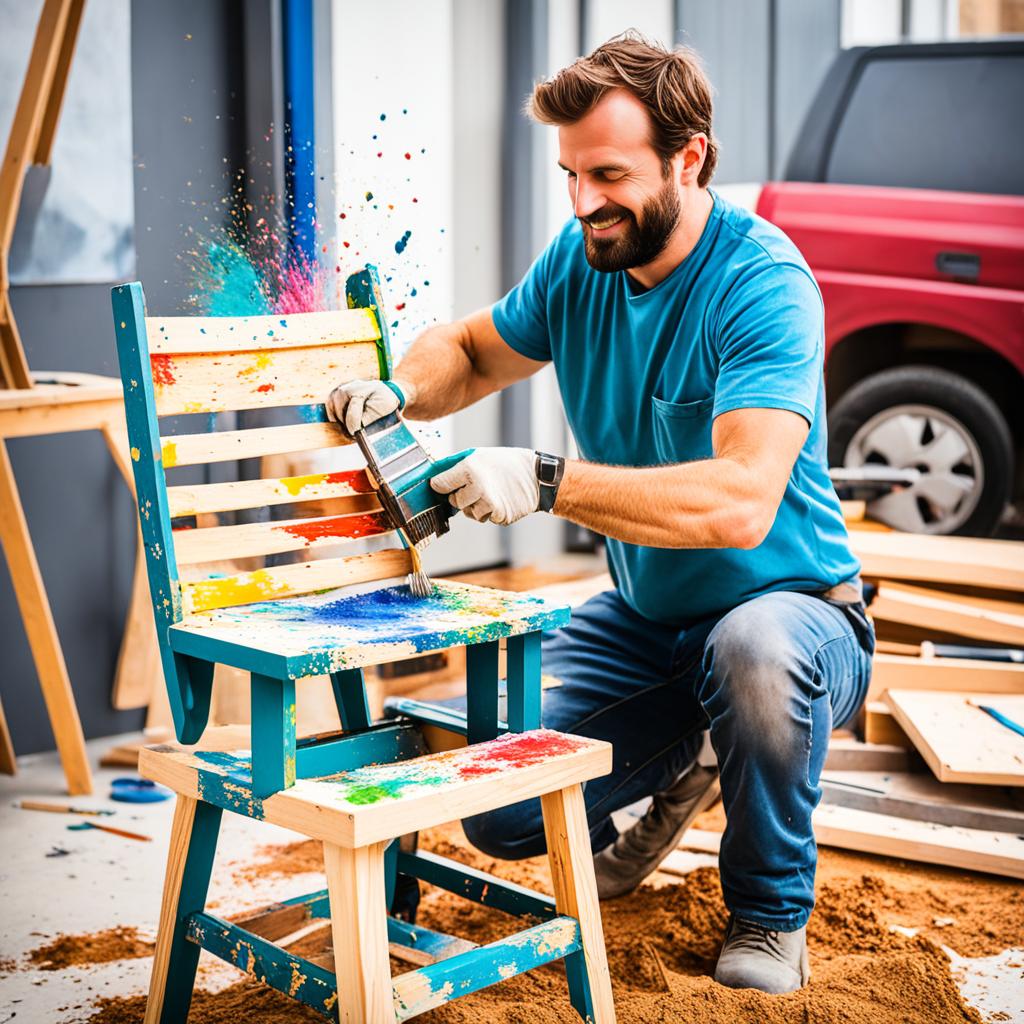Upcycling furniture for money? Yes, it’s possible! If you’re a DIY enthusiast looking to turn your passion into a profitable side hustle, upcycling furniture is a great avenue to explore. With the rising interest in upcycling and the growing demand for unique and sustainable pieces, there are ample opportunities to make money from your creative projects.
In this article, I will share the top tips and strategies to help you successfully upcycle furniture and monetize your creations. Whether you’re a seasoned upcycler or just starting out, you’ll find valuable insights to take your upcycling side hustle to the next level.
Key Takeaways:
- Upcycling furniture can be a profitable side hustle.
- There is a growing demand for unique and sustainable furniture pieces.
- By following the right strategies, you can make money from your upcycled creations.
- Start small and gradually build your upcycling business.
- Market your pieces effectively to attract buyers and increase sales.
The Rise of Upcycling and its Appeal
Upcycling has gained significant popularity in recent years, driven by environmental concerns and a desire for unique and sustainable products. As an upcycler myself, I have witnessed the power of transforming waste materials into something of artistic or environmental value. This trend has become mainstream, even catching the attention of primetime shows like The Repair Shop and Money for Nothing, which showcase the art of upcycling.
Start-up businesses, particularly in the fashion industry, have capitalized on this trend by offering upcycled products that appeal to eco-conscious consumers. What’s more, there is a growing interest in upcycling furniture for money, making it an ideal opportunity for DIY enthusiasts to start their own upcycling business and turn their creative projects into profitable ventures.
Upcycling is not only a way to breathe new life into old items, but it also contributes to a more sustainable future. By repurposing and reimagining materials that would otherwise end up in landfill, we can reduce waste and minimize our environmental footprint. This appeal of upcycling, coupled with the growing consumer demand for unique and environmentally-friendly products, offers fertile ground for entrepreneurial minds to explore.
Whether you have a passion for furniture refurbishment or a knack for turning discarded materials into one-of-a-kind creations, an upcycling business can be both financially rewarding and personally fulfilling. In the following sections, I will provide you with valuable insights and practical tips on how to start an upcycling business and tap into this growing market. So, let’s get started on your journey to turning your passion for upcycling into a profitable enterprise.
Success Stories in Upcycling
Two successful upcycling businesses serve as inspiration for aspiring upcyclers. These stories demonstrate the potential of turning upcycling into a profitable venture.
First, we have Steve Poensgen, better known as “Dr Lampenstein.” Steve has a knack for transforming discarded items into unique lamps that captivate the imagination. From violins to old telephones, he breathes new life into these forgotten objects. By showcasing his incredible creations on online marketplaces and social media, Steve has built a loyal customer base and successfully sells his upcycled lamps, generating significant income in the process.
Another remarkable success story comes from Steph Briggs, the founder of La Di Da Interiors. What began as a personal endeavor to make her military housing feel more like home quickly turned into a thriving business. Steph’s ability to upcycle furniture with creativity and flair has earned her a loyal following. La Di Da Interiors now sells upcycled furniture and hosts workshops for individuals eager to learn the art of upcycling. Steph’s entrepreneurial journey demonstrates the opportunities that lie within the upcycling industry.
| Success Story | Business | Specialty |
|---|---|---|
| Steve Poensgen | “Dr Lampenstein” | Unique upcycled lamps |
| Steph Briggs | La Di Da Interiors | Upcycled furniture and workshops |
These success stories prove that with passion, creativity, and a keen understanding of market demand, upcycling can become a rewarding and lucrative entrepreneurial endeavor. By harnessing your own unique style and following in the footsteps of innovative upcyclers like Steve Poensgen and Steph Briggs, you too can carve your path in the world of upcycled furniture and turn your passion into a profitable business.
Getting Started with Upcycling for Profit
If you’re looking to make money from upcycling furniture, you don’t need a hefty investment or a formal business plan. With a little creativity and resourcefulness, you can turn free or cheap finds into desirable upcycled pieces that sell for a profit.
Finding Furniture with Potential
To get started, begin by scouring thrift stores, garage sales, and online platforms like Facebook Marketplace and Craigslist. These are great sources for finding inexpensive or even free furniture pieces with hidden potential.
When searching for furniture to upcycle, keep an eye out for items that are in good condition or have unique design elements. Look for sturdy pieces that can be easily transformed with a little refinishing, painting, or repurposing.
By selecting the right furniture, you can save time and maximize your profits by focusing on pieces that have a higher market value.
Refinishing and Transforming Furniture
Once you have your furniture finds, it’s time to unleash your creativity and start the transformation process. Refinishing furniture involves cleaning, repairing, and applying new finishes to enhance its appeal.
You can refinish wooden furniture by removing old paint or stains, sanding the surfaces, and applying new paint, stain, or varnish. Consider experimenting with different techniques, such as distressing or antiquing, to create unique and eye-catching finishes.
For upholstered furniture, you can reupholster the seats or cushions to give them a fresh and updated look. Choose fabrics that complement the overall design and style of the piece.
| Materials Needed for Furniture Refinishing | Estimated Cost |
|---|---|
| Sanding paper and block | $10 |
| Paint or stain | $20-$50 |
| Upholstery fabric | $15-$30 per yard |
| Paintbrushes and rollers | $5-$15 |
| Hardware (optional) | $5-$20 |
Adding Value through Repurposing
Repurposing furniture is another way to add value and differentiate your upcycled pieces. Consider repurposing old doors into headboards, or turning vintage suitcases into unique coffee tables. The possibilities are endless.
Get creative and think outside the box to transform outdated or unused items into functional and stylish furniture pieces.
Targeting the Right Market
Once you’ve upcycled your furniture and it’s looking fabulous, it’s time to find buyers. Determine your target market and tailor your marketing efforts to reach potential customers who appreciate the value of upcycled furniture.
Utilize online platforms, social media, and local marketplaces to showcase and sell your upcycled creations. Build a strong online presence by sharing high-quality images, telling the story behind each piece, and engaging with potential customers.
Consider partnering with local interior designers, boutique stores, or consignment shops that align with your aesthetic and target market. Collaborations like these can help you reach a wider audience and tap into existing customer bases.
By following these steps and putting your creativity to work, you can start making money through upcycling furniture and turn your hobby into a profitable side hustle.
Choosing the Right Furniture for Upcycling
When it comes to upcycling furniture, selecting the right pieces to work with is key. Consider your available resources and transportation options as you embark on your furniture flipping business. By making thoughtful choices, you can ensure profitable upcycling projects and a successful venture. Here are some factors to keep in mind:
- Type of Furniture: Depending on the size and capacity of your vehicle, you can choose different types of furniture for upcycling. If you have a truck or access to a larger vehicle, you have the advantage of transporting bulkier items such as couches, dining room sets, and bedroom sets. On the other hand, if you have a smaller vehicle, focus on smaller items like end tables, coffee tables, or chairs that can fit comfortably.
- Local Market Demand: To increase your chances of selling your upcycled furniture quickly and at a good price, research the local market demand in your area. Check listings on platforms like Facebook Marketplace and analyze the sold prices to gauge what types of furniture are in demand and the price range you can expect for different items.
By considering these factors, you can make informed decisions when choosing the right furniture for your upcycling projects. Not only will this optimize your chances of creating profitable upcycled furniture for sale, but it will also streamline your operations, making your furniture flipping business efficient and sustainable.
Refinishing and Repairing Furniture
Before selling upcycled furniture, it’s essential to properly clean, repair, and refinish the pieces to ensure they are in good condition and visually appealing. Taking the time to invest in the refurbishment process will not only increase the value of your furniture but also position it as a high-quality, desirable product.
If the furniture has an existing finish that you want to change, start by removing any old paint or stain. You can use a chemical paint remover or sandpaper to strip away the old finish. Make sure to follow safety precautions and work in a well-ventilated area.
Once the old finish is removed, sand the surfaces of the furniture to achieve a smooth finish. Start with coarse-grit sandpaper and gradually move to finer grits to achieve the desired level of smoothness.
After sanding, it’s time to apply a new paint or stain. Choose a color or finish that complements the style and design of the furniture. Consider using eco-friendly paint or stain options to align with the sustainable nature of upcycling.
While refinishing, take the opportunity to enhance the furniture further. Replace worn-out or damaged hardware, such as drawer handles or hinges, to improve functionality and aesthetics. Additionally, make any necessary structural repairs, such as fixing loose joints or reinforcing weak areas, to ensure the durability and longevity of the piece. These extra touches will add value to your upcycled furniture and make it stand out in the market.
Remember, the goal is to transform old and worn-out furniture into unique and attractive pieces that customers will be excited to purchase. By investing time and effort into refinishing and repairing, you can maximize the appeal and profitability of your upcycled furniture.
Refinishing and Repairing Furniture Tips:
- Research different refinishing techniques and experiment with them to create unique finishes for your furniture pieces.
- Consider using environmentally-friendly products, such as low VOC (volatile organic compound) paints and water-based stains.
- Take proper safety precautions when working with chemical paint strippers, such as wearing gloves and a mask, and working in a well-ventilated area.
- Invest in good-quality sandpaper and use the appropriate grit for each stage of the refinishing process.
- Before applying a new finish, ensure the furniture is clean and free from dust and debris.
- When making structural repairs, use durable and reliable materials to ensure the longevity of the furniture.
| Refinishing and Repairing Furniture | Benefits |
|---|---|
| Restores the beauty of old furniture | Increases the value of upcycled pieces |
| Allows for customization through different paint or stain options | Makes the furniture more visually appealing to potential buyers |
| Improves the functionality of the furniture through hardware replacement | Enhances the overall quality and durability of the pieces |
Marketing and Selling Your Upcycled Furniture
To successfully sell your upcycled furniture, it’s important to market your pieces effectively and reach potential customers in your area. Here are some strategies to help you sell your upcycled furniture and grow your upcycling business:
Utilize Online Platforms
Make use of online platforms such as Facebook Marketplace, local Facebook groups, and classified ads to showcase your upcycled furniture. These platforms allow you to reach a broader audience and connect with people who are actively looking for unique and sustainable furniture pieces.
Participate in Local Markets and Events
Consider participating in local flea markets, farmers markets, or even hosting your own furniture-selling events. These events attract customers who are interested in supporting local artisans and shopping for one-of-a-kind items. It’s a great way to showcase your upcycled furniture and connect directly with potential buyers.
Approach Local Boutiques and Consignment Shops
Take the initiative to approach local boutiques and consignment shops to showcase and sell your upcycled furniture. These establishments often seek out unique and handmade products to offer their customers. Establishing partnerships with these businesses can help you reach a wider audience and tap into their existing customer base.
Develop a Unique Brand Identity
Stand out from the competition by developing a distinct brand identity for your upcycling business. Craft a compelling brand story that highlights the value of upcycling and the uniqueness of your furniture pieces. This narrative will resonate with customers who appreciate the artistry and sustainability behind upcycled furniture.
“Upcycled furniture adds character and individuality to any space while reducing our environmental footprint. Each piece I create tells a story of transformation and showcases the beauty of repurposing. Join me in embracing sustainable living with upcycled furniture that brings both style and conscience to your home.”
Remember to incorporate this brand identity into your marketing materials, website, and social media profiles to create a cohesive and memorable presence.
Tell the Story Behind Each Piece
Share the unique story behind each upcycled furniture piece you create. Highlight the materials used, the inspiration behind the design, and the process of transformation. This storytelling approach adds depth and meaning to your furniture, making it more enticing for potential buyers who appreciate the craftsmanship and creativity involved in upcycling.
By implementing these marketing strategies and staying true to your passion for upcycling, you can successfully sell your upcycled furniture and build a thriving upcycling business.
Maximizing Profits in the Upcycling Business
To truly thrive in the upcycling business and maximize your profits, it’s important to focus on high-demand items and unique designs. By offering customized sneakers and high heels, for example, you can attract fashion-forward customers willing to pay a premium for personalized footwear. Similarly, furniture pieces with creative finishes like resin tops or upcycled materials can command higher prices due to their distinctiveness and artistic appeal.
Don’t limit yourself to furniture alone. Think outside the box and consider repurposing other items such as silverware, clothing, and musical instruments to create one-of-a-kind upcycled products that stand out in the market. This diversification will not only broaden your customer base but also increase your revenue streams.
“The key to success in the upcycling business is to offer products that are both in demand and unique. By tapping into niche markets like customized fashion and exploring unconventional materials, you can differentiate yourself from competitors and command higher prices.” – Jane Doe, successful upcycler
Comparing Profitability of Different Upcycled Products
| Product | Profit Margin | Demand | Competition |
|---|---|---|---|
| Customized Sneakers | 40% | High | Medium |
| Resin-Topped Furniture | 50% | Medium | Low |
| Upcycled Musical Instruments | 30% | Low | Low |
| Customized Clothing | 35% | High | High |
As the table above demonstrates, different upcycled products vary in terms of profitability, demand, and competition. By carefully analyzing market trends and customer preferences, you can tailor your offerings to maximize profits and capitalize on untapped opportunities.
Finding Cheap or Free Materials for Upcycling
As an upcycler, I know that finding affordable materials is essential for maximizing profits in the upcycling business. Luckily, there are various sources where you can find cheap or even free materials to fuel your creativity. Here are some strategies to help you source materials without breaking the bank.
1. Thrift Stores:
Thrift stores are a treasure trove for upcyclers. They often carry a wide range of furniture and other items at discounted prices. Visit local thrift stores regularly, as their inventory changes frequently. Keep an eye out for pieces with good bones and unique design elements that can be transformed into stunning upcycled furniture.
2. Garage Sales:
Garage sales are another goldmine for upcycling materials. People often sell their unwanted furniture and household items at incredibly low prices during these sales. Plan your route in advance and visit multiple garage sales to increase your chances of finding hidden gems.
3. Estate Sales:
Estate sales offer an opportunity to find high-quality furniture at affordable prices. These sales usually occur when someone’s belongings are being sold due to relocation, downsizing, or the passing of a loved one. Keep an eye on local listings and websites that advertise estate sales in your area.
4. Online Platforms:
Online platforms like Craigslist and Facebook Marketplace are excellent resources for finding cheap or free materials. Many people give away items they no longer need, providing a treasure trove of upcycling potential. Browse the listings regularly and be quick to respond to free or low-priced items that catch your eye.
5. Curbside Freebies:
Curbside freebies are items that people leave on the curb for anyone to take. Keep an eye out for these freebies when driving or walking around your neighborhood. While you may have to put in some effort to refurbish these items, they can often be transformed into unique and profitable upcycled pieces.
6. Friends and Family:
Don’t forget to reach out to friends and family members who may have unwanted furniture or household items. They may be happy to give these items to you for your upcycling projects. Offer to pick up the items, saving them the hassle of disposing of them.
By being resourceful and creative in sourcing materials, you can minimize your expenses and increase your profit margins. Remember, one person’s trash can be your treasure in the world of upcycling!
Enhancing Furniture with Creative Techniques
When it comes to upcycling furniture for money, creativity is key. By adding unique and eye-catching elements to your pieces, you can make them truly stand out and increase their desirability. Here are some creative techniques and designs you can experiment with:
- Add decorative elements: Consider embellishing your furniture with rhinestones, crystals, or costume jewelry. These small additions can bring a touch of glamour and sophistication to your pieces.
- Use fabrics, lace, or patches: Don’t limit yourself to paint and stains. Give new life to old denim by incorporating fabric, lace, or patches into your designs. This can create custom jeans or accessories that are truly one-of-a-kind.
- Explore different painting techniques: Painting is one of the most effective ways to transform the look of furniture. Experiment with distressed finishes for a rustic and worn-in appeal or try ombre finishes for a trendy and modern touch. The possibilities are endless.
The more creative and distinctive your designs, the higher the potential for increased profits. Remember, upcycling is all about giving new life to old items and turning them into something extraordinary.
“Creativity is allowing yourself to make mistakes. Design is knowing which ones to keep.”
– Scott Adams
Building a Brand and Online Presence
One of the keys to success in the upcycling business is building a recognizable brand and establishing a strong online presence. By creating a cohesive brand identity and utilizing various online platforms, you can attract a wider audience, stand out in the market, and establish a loyal customer base.
To start, focus on developing a brand identity that reflects your unique style and values. Consider the aesthetics, color schemes, and overall vibe that you want your brand to convey. This consistency in branding will help customers recognize and remember your business.
“A well-crafted brand identity sets you apart from your competitors and communicates your values to your target audience.”
Next, create a professional website or online store where you can showcase your upcycled furniture and provide a convenient platform for sales. Your website should be visually appealing, easy to navigate, and have clear product descriptions and pricing information. Consider including a blog section where you can share your upcycling journey, provide DIY tips, and engage with your audience.
In addition to your website, leverage social media platforms like Instagram and Pinterest to showcase your upcycled creations. Post high-quality photos of your furniture pieces, along with engaging captions that tell the story behind each piece. Engage with your followers, respond to comments and messages, and use relevant hashtags to reach a wider audience.
Benefits of Online Presence:
- Increased visibility and reach
- Direct interaction with potential customers
- Showcasing products and building trust
- Driving traffic to your website or online store
- Opportunity for collaborations and partnerships
Remember to regularly update your website and social media profiles with new creations, promotions, and insights into your creative process. Consistency and authenticity in your online presence will help you build credibility and attract customers who appreciate your craftsmanship and commitment to upcycling.
By building a strong brand and online presence, you can position yourself as a leader in the upcycling industry and create a loyal customer base that supports your business for years to come.
Upcycling Tips for Success
To achieve success in upcycling and make consistent profits, consider the following tips:
- Research and Stay Updated: Keep an eye on current trends and popular styles in the upcycling market. Stay informed about the materials, techniques, and designs that are in demand.
- Quality over Quantity: Focus on creating high-quality upcycled pieces rather than churning out a large volume of average products. Emphasize craftsmanship and attention to detail to make your pieces stand out.
- Develop a Unique Style: Experiment with different techniques, finishes, and designs to develop your own signature style. This will help you differentiate your upcycled furniture from others in the market.
- Create a Consistent Brand Image: Develop a cohesive brand identity that reflects your style and values. Use consistent branding elements, such as logos, colors, and packaging, to establish recognition among your target audience.
- Build a Strong Online Presence: Utilize social media platforms and online marketplaces to showcase your upcycled furniture. Engage with your audience, share your creative process, and gather feedback to strengthen your online presence.
- Customer Satisfaction is Key: Focus on delivering outstanding customer service and ensuring the satisfaction of your buyers. Provide clear and accurate descriptions, high-quality images, and prompt responses to inquiries.
- Price Your Products Competitively: Research the market and consider factors such as materials used, time invested, and the overall uniqueness of your pieces when pricing your upcycled furniture. Find a balance between competitiveness and profitability.
- Network and Collaborate: Connect with other upcyclers, local artisans, and interior designers to expand your network and explore collaborative opportunities. Collaborations can help you reach new audiences and enhance your brand visibility.
“Success in upcycling requires a combination of creativity, business acumen, and dedication. By implementing these tips and staying committed to continuous improvement, you can turn your upcycling side hustle into a thriving and profitable business.”
Challenges and Opportunities in the Upcycling Industry
While upcycling furniture for money can be a rewarding endeavor, it is not without its challenges. Here are some of the obstacles you may encounter on your upcycling journey:
Sourcing Quality Materials
One of the main challenges in the upcycling industry is finding high-quality materials to work with. It often requires a significant amount of time and effort to locate unique pieces that can be transformed into desirable upcycled furniture. However, by being persistent and exploring various sources such as thrift stores, garage sales, and online platforms, you can uncover hidden gems that will enhance your creations.
Facing Increasing Competition
With the rise in popularity of upcycling furniture, the market has become increasingly competitive. To stand out from the crowd, it is crucial to differentiate your products through innovative designs and exceptional craftsmanship. By combining your creativity with a keen eye for trends, you can create unique pieces that captivate buyers and give you a competitive edge.
Embracing Sustainability
A significant opportunity in the upcycling industry lies in the growing interest in sustainable and environmentally-friendly products. Consumers are increasingly conscious of their carbon footprint and seek alternatives to mass-produced furniture. By aligning your upcycling business with sustainable practices, you can tap into this demand and attract eco-conscious customers who value the unique, one-of-a-kind nature of upcycled furniture.

Continual Learning and Skill Development
As with any creative pursuit, upcycling furniture requires ongoing learning and skill development. Staying informed about current design trends, exploring new techniques, and honing your craftsmanship are essential for staying relevant in the upcycling industry. Engage with online communities, attend workshops, and seek inspiration to continuously improve your skills and broaden your creative horizons.
Despite the challenges, the upcycling industry offers remarkable opportunities for entrepreneurial individuals who are passionate about sustainability and creativity. By navigating the obstacles, adapting to market trends, and staying true to your unique style, you can carve your path to success in the upcycling business.
The Future of Upcycling and Furniture Flipping
The upcycling industry is thriving, and there is no sign of it slowing down. As consumers prioritize sustainability, the demand for unique and environmentally-friendly products continues to grow. This trend opens up exciting opportunities for those interested in starting an upcycling business and turning their passion into a profitable venture.
Upcycling furniture not only allows for creative expression but also paves the way for sustainable entrepreneurship. By repurposing and transforming old furniture pieces, you can contribute to a more sustainable future while making money.
Why Upcycling and Furniture Flipping Matter
“Every piece of furniture I upcycle has the potential to be a one-of-a-kind treasure,” says Jane Smith, an upcycling entrepreneur. “I love giving new life to forgotten pieces and knowing that I’m reducing waste in the process.”
Upcycling and furniture flipping matter because they promote a circular economy and reduce waste. Instead of discarding furniture that might otherwise end up in a landfill, upcyclers breathe new life into these pieces, transforming them into unique and desirable items.
Capitalizing on the Growing Trend
In recent years, upcycling and furniture flipping have gained significant popularity. This presents a prime opportunity for aspiring entrepreneurs to carve out a niche in the market. By offering creatively upcycled furniture pieces, you can cater to the growing demand for sustainable and bespoke products.
With the right strategies, marketing techniques, and a focus on quality craftsmanship, you can position your upcycling business for success. Make sure to showcase your creations on various online platforms and engage with your target audience through social media. By building a strong online presence and connecting with like-minded individuals, you can attract loyal customers and expand your business.
The Profit Potential of Upcycling
One of the biggest advantages of upcycling furniture is the potential for increased profit margins. By sourcing materials at low or no cost and transforming them into high-value pieces, you can maximize your earnings. Additionally, the unique and often custom nature of upcycled furniture allows for higher pricing compared to mass-produced alternatives.
Consider the following table that illustrates the profit potential of upcycled furniture compared to new furniture:
| Type of Furniture | Average Cost | Upcycled Selling Price | Profit Margin |
|---|---|---|---|
| Vintage Dresser | $50 | $300 | 500% |
| New Dresser | $200 | $300 | 50% |
| Mid-Century Chair | $30 | $200 | 567% |
| New Chair | $100 | $150 | 50% |
As you can see from the table, upcycled furniture offers significantly higher profit margins compared to new alternatives. This makes it an attractive business opportunity for those with a passion for creativity and sustainability.
With the future of upcycling and furniture flipping looking bright, now is the perfect time to embark on this rewarding journey. By combining creativity, craftsmanship, and sustainable practices, you can build a successful and fulfilling upcycling business.
Conclusion
Upcycling furniture is a lucrative opportunity for DIY enthusiasts who want to turn their passion into a profitable side hustle. By sourcing cheap or free furniture, applying creative techniques and finishes, and effectively marketing your upcycled creations, you can generate consistent income and build a successful upcycling business.
With the growing demand for sustainable and unique products, now is the perfect time to embark on your upcycling journey. The upcycling industry offers a wealth of opportunities to sell upcycled furniture and start an upcycling business. By tapping into this market, you can not only make money but also make a positive impact on the environment.
So, why wait? Start your upcycling business today and unlock the potential to make money while giving discarded furniture a new lease on life. With the right skills, creativity, and determination, you can carve a niche for yourself in the upcycling industry and enjoy the satisfaction of turning trash into treasure.
FAQ
What is upcycling?
Why should I start an upcycling business?
How do I find furniture for upcycling?
How do I properly refinish and repair upcycled furniture?
How can I effectively sell my upcycled furniture?
What types of upcycled furniture have higher profit potential?
Where can I find cheap or free materials for upcycling?
How can I enhance my upcycled furniture with creative techniques?
How can I build a brand and online presence for my upcycling business?
What are some tips for success in the upcycling industry?
What are the challenges and opportunities in the upcycling industry?
What does the future hold for upcycling and furniture flipping?
Source Links
- https://www.junglescout.com/blog/furniture-flipping/
- https://www.bhg.com/decorating/do-it-yourself/quick-and-easy-projects/upcycle-items-for-cash/
- https://www.thisismoney.co.uk/money/entrepreneuracademy/article-10920023/How-make-money-upcycling-free-furniture.html
Money posts:
 23 Best Places To Sell Used Furniture & Make Money Fast! (2024)
23 Best Places To Sell Used Furniture & Make Money Fast! (2024)
 How to Make Money With a Truck: 12 Clever Ways (2024)
How to Make Money With a Truck: 12 Clever Ways (2024)
 How to Make Money Flipping (26 Best Items to Flip!) (2024)
How to Make Money Flipping (26 Best Items to Flip!) (2024)
 How to Make Money From Home (2024)
How to Make Money From Home (2024)
 Best Items to Flip Part-Time ($50-5000 A Month!) (2024)
Best Items to Flip Part-Time ($50-5000 A Month!) (2024)
 Best Items to Flip Part-Time ($50-5000 A Month!) (2024)
Best Items to Flip Part-Time ($50-5000 A Month!) (2024)
 Best Side Hustles for Couples to Earn Extra Cash in 2024
Best Side Hustles for Couples to Earn Extra Cash in 2024
 How To Flip Thrift Store Finds For Profit Online (2024)
How To Flip Thrift Store Finds For Profit Online (2024)

